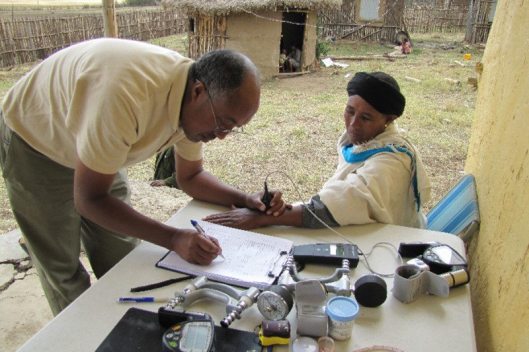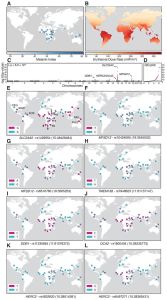Most associate dark skin with African peoples, but there are a wide variety of populations who represent an even wider array of skin tones, from the light beige skin of the San to the deep black skin of the Dinka. A new study published online this week in Science, identifies a handful of new gene variants responsible for this palette of tones and compares them to some we already knewlike SLC24A5 and its SNPs, which we now know as the ‘depigmentation gene’ and is associated with the a pale skin phenotype that swept through Europe 6,000 years ago. Prior studies of a skin pigmentation gene called MC1R had led many geneticists to think that dark skin colour – which is thought to protect against UV damage – is a fixed and consistent trait in all people of African descent.
Evolutionary geneticist Sarah Tishkoff of the University of Pennsylvania, the lead author of the new study measured the reflectance of light on the skin of 2,092 people from Ethiopia, Tanzania, and Botswana along with Nicholas Crawford. The eastern African groups, like the Mursi and Surma, had the darkest skin on objective reflectance assessments, and the lightest are the San with shades between such as the Agaw.
Concurrently, they collected blood samples of 1,570 of these people for genetic studies and sequenced more than 4 million SNPs. They found 8 sites of the human genome that are particularly associated with the level of skin pigmentation which makes up for 30% of the variation in skin tone we see. Four key areas of the genome, which emerged 900,000 years ago, have specific SNPs that correlate directly with skin color.
SLC24A5, that gene I commented on before, and that we’ve known about for over 12 years to be associated with lighter skin tones, is common in some Ethiopian populations. Variants of this gene appeared 30,000, likely from Middle Eastern groups returning to eastern Africa. Variants of two neighboring genes, HERC2 and OCA2, which are also associated with light skin, eyes, and hair phenotypes seen in Europeans ultimately arose in Africa. The SNPs we see in Europeans are ancient and common in the light-skinned San people. The team proposes that these SNPs arose in Africa over 1 million years ago and spread later to Europeans and Asians. Which is incredible and I’ll comment on later.
I think the most dramatic discovery is of MFSD12. Two SNPs which decrease expression of this gene were found in high frequencies in people with the darkest skin. They confirmed in culture cells that these mutant MFSD12 genes lead to more eumelanin. These variants arose about a 500,000 years ago, suggesting that human ancestors before that time may have had moderately dark skin, rather than the deep black hue created today by these mutations. These same two variants are found in Melanesians, Australian Aborigines, and some Indians, which implies that these groups may have inherited the variants from ancient migrants from Africa who followed a “southern route” out of East Africa, along the southern coast of India to Melanesia and Australia.
The latest findings suggest that some particularly dark skin tones evolved relatively recently from paler genetic variants, and these people migrated out of Africa. SNPs in OCA2 and HERC2 that are associated with lighter skin are ancient, over 1 million years old and come from Africa. This all underlines how deeply flawed the racist concept of people with lighter skin being “more advanced” really is…. Which as we all know there is a deep, broken cultural association with skin pigmentation with intellectual traits or traits dealing with moral behaviour.
Fig. 1 Correlations between allele frequencies at genes associated with pigmentation and UV exposure in global populations. A) Global variation in skin pigmentation indicated by Melanin index (MI). This data was integrated with MI data for global populations from (1, 102). (B) Mean erythemal dose rate. (C) Manhattan plot of -log10 transformed p-values from GWAS of skin pigmentation with the Illumina Omni5 SNP array. (D) Quantile-Quantile plot of observed vs expected p-values from the GWAS. In both (C) and (D) significant SNPs at p < 5 × 10−8 are highlighted in purple. (E to L) Allele frequencies of genetic variants associated with skin pigmentation in global populations. African populations included are 1. Ethiopia Nilosaharan, 2. Ethiopia Omotic, 3. Ethiopia and Tanzania Cushitic, 4. Ethiopia Semitic, 5. Tanzania Nilosaharan, 6. Tanzania Hadza, 7. Tanzania Sandawe, 8. Botswana Bantu 9. Botswana San/Bantu admixed, and 10. Botswana San. The Melanesian (MEL) samples are from (12) and the Australian Aboriginal and Papua New Guinean samples (merged) are from the SGDP (PNG) (13). All other populations are from the TGP (10). Non-Aboriginal populations in the Americans are indicated: CEU (European ancestry), ASW (African-American Southwest US) and ACB (African Caribbean in Barbados).
Posted in Blog, Physical Anthropology
Source: https://anthropology.net/2017/10/12/on-the-evolution-of-skin-tones-in-africa/






